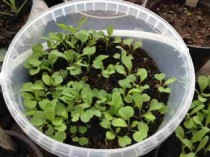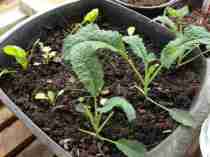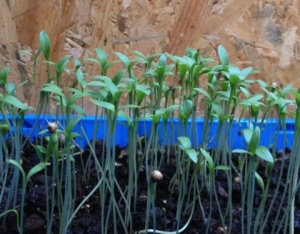 April has not been kind, it rarely is here, but this year it seems particularly unkind. We have had 21 days of rain, a total of 152 mm (6 inches), and a couple of light falls of snow; the average overnight temperature has been a mere 2℃ and we have had frosts on nine days. The greenhouse has fared better with an average low of 8℃ and reaching 20℃ most days, if only for a few hours. The daffodils and tulips don’t seem to mind though. This beautiful tulip is ‘Red Georgette’.
April has not been kind, it rarely is here, but this year it seems particularly unkind. We have had 21 days of rain, a total of 152 mm (6 inches), and a couple of light falls of snow; the average overnight temperature has been a mere 2℃ and we have had frosts on nine days. The greenhouse has fared better with an average low of 8℃ and reaching 20℃ most days, if only for a few hours. The daffodils and tulips don’t seem to mind though. This beautiful tulip is ‘Red Georgette’.
The greenhouse is full to bursting but germination is slow and plant growth is sluggish. Outside the soil is still too cold to risk sowing seeds and is mostly still covered in black plastic to try to warm it up and to keep the weeds under control. The aforesaid weeds seem to have no difficulty in romping away in their usual thuggish manner. To quote the wonderful Ian Dury:
“Is this fair, my little ones, is this fair?
No, it f*****g ain’t!”
So, how is the salad challenge fairing through all this? Many weeks ago I sowed lettuce and spinach seeds under the staging in the greenhouse in the hope of having something fairly quickly to add to the very limited supply of mizuna and mustard that survived the winter. The lettuces germinated quickly, looked around, clearly didn’t like what they saw and promptly keeled over. The spinach germination rate was poor but at least they didn’t die, unfortunately they didn’t grow either, just sat there being nibbled at by something. Lesson learnt: the soil at ground level in the greenhouse is nearly as cold as that outside.
Then I read a blog post by someone (unfortunately, I have forgotten who it was so I cannot give them credit) who had success growing salad in an old washing up bowl, so now I have an old fatball container packed with mixed lettuce seedlings and a washing up bowlful of black kale, the spinach survivors from under the staging and a few celery leaf seeds.
I I
I intentionally over-sowed the lettuce seeds and the thinnings give an intense kick to salads, and I love the flavour of raw young kale leaves. The spinach is thankfully starting to recover. The parsley seedlings that I grew on the window sill back in early March are now in the greenhouse and large enough to harvest a few leaves occasionally. A couple of times I have nearly picked Amni Majus leaves by mistake, the seed leaves look very similar (it is only an up-market cow parsley, after all!).
 The coriander is romping away now and I have risked putting some outside under cloches made from five litre water bottles to protect them from the wind.
The coriander is romping away now and I have risked putting some outside under cloches made from five litre water bottles to protect them from the wind.
I also have a mini dill forest in a pot. It looks so pretty and feels so soft and wafty that I just have to let my hand roll gently over it as I pass. It doesn’t seem to mind .
We are not eating as much home grown salad as I would like yet but I get enormous satisfaction from picking a bit of this and a little of that. It just seems so much more precious a harvest than a load of past-its-best shop bought leaves. Yesterday for lunch I prepared a bowlful of white cabbage and broccoli (both bought) plus kale, lettuce seedlings, mustard leaf, mizuna leaf and flowers, garlic chives, marjoram and lemon thyme. I thought it was delicious but the conversation with Alec went something like this:
Alec: (prodding yellow bits) “What exactly is this you are giving me?”
Me: “Mizuna flowers”
Alec: “Mmm”
Me: “This is a really nice salad, don’t you think?”
Alec: “I like the dressing”.
This salad challenge thing is most definitely still a work in progress!







